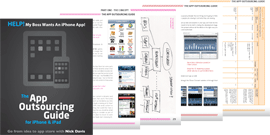First thing’s first. If you weren’t aware, you need to know: once your app is completed, finished, done, you can’t just press ‘GO’ and have it appear on the App Store. Apple has to approve your app first, so you need to understand that:
- Depending on how busy they are, Apple will likely take around a week (though less, if you’re lucky) or even two weeks to review your app;
- After that time, they might still reject it. If that happens (and whatever reason they give for rejecting it is fixable, eg. a bug) you can re-submit the app once you’ve made the appropriate fix or change, but guess what? When you re-submit you’ll be star ting from the back of the queue again and have to wait another week or more.
This should give you a few things to think about.The first being:
‘I need to build in some time at the end of the project for Apple to approve the app.’
and then perhaps:
‘I have no control over that process’;
‘I don’t know exactly how long I will have to wait’;
‘I might even get rejected meaning I have to re-submit and wait again’
So if you have dependencies (a sponsor) or other stakeholders (colleagues) and you need to build some time in for this, you might also want to make sure they have a basic understanding of the process and some of the possible scenarios. It should also make you very determined – if being rejected is something that will throw your project off- schedule – that your app is bug-free and not likely to get bounced by Apple.
The other thought that might also enter your head on hearing all this is:
‘My app might NEVER get approved!’
So before you sink a $50k app budget into developing the coolest app idea on the planet or spend two weeks putting together a complex proposal, we’d recommend familiarising yourself with the latest guidelines from Apple on what is likely to be allowed on the store and what is likely to get rejected.
Before these were first published in September 2010 (there was nothing before), developers were never quite sure what the real guidelines were. So if this your first app be grateful you now have some guidance at least.
The guidelines are described by Apple as a ‘living document’ and so may change at any time. In order to make sure you are viewing the latest guidelines then, you should visit: developer.apple.com/appstore/resources/approval/guidelines.html (if you are not yet registered with Apple you will have to do so before you can access these – if you don’t know how to do this, see the dedicated section later in this chapter).
To give you some general guidance though (again, these may change but the core principles are unlikely to):
- If your app contains violent or adult themes then you will have to approach this very carefully, read the guidelines from Apple and make sure you follow them exactly and within the spirit they are intended (even then submission is not guaranteed).Also take a look at similar apps that may have made it in the App Store already.Though just because they made it on there doesn’t mean you will automatically be accepted (it pays to do as much research as possible beforehand).
- Bugs, crashes and poorly presented apps. Perhaps needless to say, but a crash or a bug is a big no no. A small bug you might get away with but anything more and you are looking at getting rejected and then it’s back to the developers (and back to the beginning of the submission queue again).You are really going to have to test it thoroughly, there is no way around it. Fortunately I’ll have some more advice on that for you later.
- Apps that try to encourage anything illegal are a big no-no, as are ‘hate’ apps targeted at a particular person or group.
- Apps that purely exist to harvest user data, offer competitions or other lottery type games are also likely to be pointed towards the exit door.
- Finally, something that might be seen as competing with what Apple are doing (you new take on iTunes might not go down so well).
